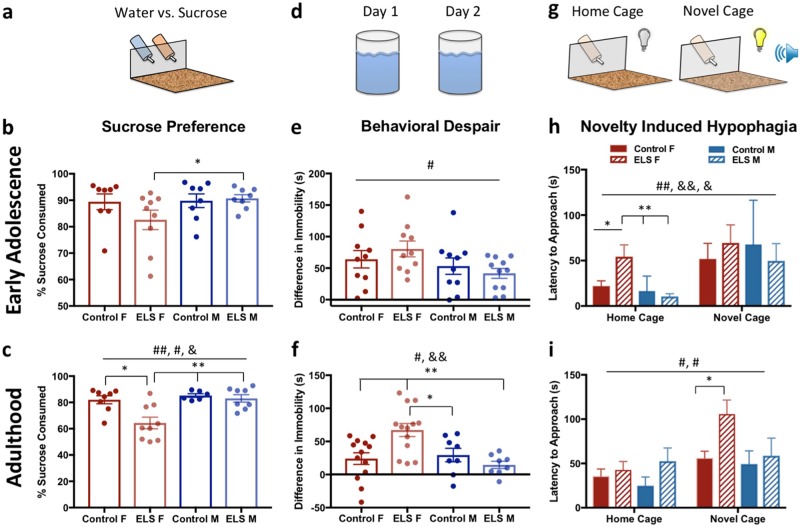Fig. 2.
Early-onset depression in female mice exposed to ELS strengthens by adulthood. a For sucrose preference, animals had a choice between water or sucrose for 3 days, percent of all liquid consumed that was sucrose is reported here. b There was no main effect of sex or treatment at early adolescence. However, a trend toward decreased sucrose preference (anhedonia) was found in ELS females (n = 9) compared with ELS males (n = 8). c In adulthood, a significant main effect of sex and treatment as well as a sex × treatment interaction were found on sucrose preference, with female ELS animals (n = 9) driving these effects, drinking significantly less sucrose water than any other group (n = 7–9). In the forced swim test, d immobility on day 2 − immobility on day 1 (baseline) is reported here. e At early adolescence, an overall effect of sex was found, with females showing greater learned helplessness overall (n = 10–11). f At adulthood, a main effect of sex as well as a significant sex × treatment interaction was found, again with ELS females (n = 13) driving these effects, showing significantly greater behavioral despair compared with any other group (control F, n = 13; control and ELS M, n = 8). g In the novelty-induced hypophagia task, latency to approach the sweet milk is reported in the home and novel cage. h In early adolescence, all animals took longer to approach the sweet milk in the novel cage than their home cage. Specifically, in their home cage, ELS female mice (n = 9) took longer to approach the sweetened milk compared with all other groups (n = 8–9). i At adulthood, there were main effects of both treatment and day, with ELS animals taking longer to approach the sweetened milk than control animals, and all animals showed increased latency to approach the milk in the novel cage. There were no differences between groups in the home cage phase of the task. In the novel cage, a significant effect was found between groups specifically with ELS females (n = 12) taking longer to approach the sweetened milk than control females (n = 12). For all plots, data show means ± 1 SEM. Significance is denoted as follows: # for main effects, & for interaction effects, and * for significant post hoc comparisons; *p < 0.05, **p < 0.005. In the case of a significant one-way analysis of variance, F statistics are reported but only the significant post hoc Bonferroni comparisons are shown

